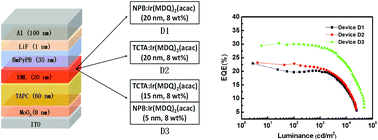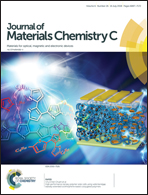High-efficiency red organic light-emitting diodes based on a double-emissive layer with an external quantum efficiency over 30%
Abstract
It has been demonstrated that the performance of organic light-emitting diodes (OLEDs) is significantly related to the emissive layer (EML) architecture. In this article, an efficient double-emissive layer (D-EML) structure based on two different hole-transporting materials as hosts, N,N′-diphenyl-N,N′-bis(1-naphthylphenyl)-1,1′-biphenyl-4,4′-diamine (NPB) and 4,4′,4′′-tri(N-carbazolyl)triphenylamine (TCTA), was designed to enhance the exciton utilization. Accordingly, the resulting red OLED shows excellent electroluminescence performance, exhibiting a maximum current efficiency of 49.2 cd A−1, a maximum power efficiency of 53.5 lm W−1 and a maximum external quantum efficiency (EQE) of 30.3%. At a high brightness of 5000 cd m−2, they still remained at 42.3 cd A−1, 21.4 lm W−1 and 25.4%, respectively. Furthermore, its device structure is very simple, with neither a p-type dopant nor an n-type dopant in the charge-transporting layers. It can be seen that the introduction of an efficient D-EML greatly improved the electroluminescence performance of the OLED.



 Please wait while we load your content...
Please wait while we load your content...